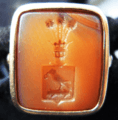Carnelian facts for kids
Carnelian is a beautiful reddish-brown stone. People often use it as a special gem. It is also sometimes called cornelian.
Carnelian is a type of mineral. It belongs to a group of stones called chalcedony. Its warm colors come from tiny bits of iron oxide inside it. Iron oxide is like rust. A stone very much like carnelian is called 'sard'. Sard is usually darker and harder. People often use the names carnelian and sard to mean the same thing. This gemstone has been used by humans for thousands of years.
Contents
What is Carnelian?
Carnelian is a type of quartz. It is a form of silica, which is a common mineral. The stone gets its lovely colors from impurities. These impurities are small amounts of iron. The colors can range from pale orange to a deep reddish-brown. Some carnelian can even look almost black.
How is Carnelian Formed?
Carnelian forms inside rocks. It grows from water rich in silica. This water fills cracks and spaces in the rock. Over a long time, the silica hardens. The iron impurities get trapped inside. This process gives carnelian its unique look.
Where is Carnelian Found?
Carnelian can be found in many places around the world. Some of the main sources are in Brazil and Uruguay. India is also famous for its carnelian. Other countries like Madagascar and the United States have it too. It is often found in volcanic rocks.
How Was Carnelian Used in the Past?
People have used carnelian for a very long time. It was popular in ancient Egypt. Egyptians believed it gave courage and protected them. They used it in jewelry and amulets. Ancient Romans also loved carnelian. They carved it into signet rings. These rings were used to seal important documents. In the Middle Ages, people thought carnelian could stop bleeding. They also believed it brought good luck.
Images for kids
-
Polish signet ring in light-orange carnelian intaglio showing Korwin coat of arms
-
Necklace with gold beads and carnelian beads, Cypriot artwork with Mycenaean inspiration, c. 1400–1200 BC. From Enkomi. British Museum.
-
Indian carnelian beads with white design, etched in white with an acid, imported to Susa in 2600–1700 BCE. Found in the tell of the Susa acropolis. Louvre Museum, reference Sb 17751. These beads are identical with beads found in the Indus Civilization site of Dholavira.
-
This Egyptian necklace consists of biconical carnelian beads, beads of rolled strips of sheet gold, and ten amulets. The Walters Art Museum.
See also
 In Spanish: Cornalina para niños
In Spanish: Cornalina para niños






